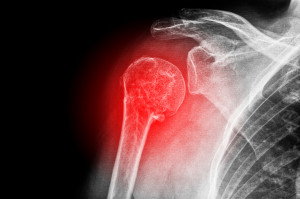Frozen shoulder – do you suffer from this problem?
In our practice, we often see patients who complain of a painful shoulder joint, especially when they try to lift their arm up.
This limited movement of the shoulder is sometimes called a frozen shoulder. Here we discuss this condition in a bit more detail, touching up on what you can do to help relieve the pain.
What Is A Frozen Shoulder?

Frozen shoulder is also called ‘adhesive capsulitis’.
This literally means that the cartilage capsule in the shoulder that protects the joint is very sticky and does not allow for smooth movement.
The shoulder is basically stiff and painful and is limited in movement. This can no doubt have an impact on the patient’s ability to perform their daily tasks.
What Causes A Frozen Shoulder?
There are a number of different causes that have been identified that can lead to frozen shoulder. But before we do that, let’s take a quick look at the shoulder joint.
The shoulder joint consists of a group of muscles, tendons and cartilage. It is typically described as a ‘ball and socket’ joint.
The muscles are wrapped around the bones in the shoulder joint, which comprise of the top of the humerus (upper arm bone), the scapula (the wing bone on the back) and the clavicle (collar bone).
The cartilage tissue encapsulates the tendons of the muscles, and within the capsule is a small amount of fluid called synovial fluid.
The synovial fluid and healthy cartilage allows for smooth movement of the shoulder joint. The video below illustrates the shoulder joint anatomy in a bit more detail.
[media url=”http://www.youtube.com/watch?v=D3GVKjeY1FM” width=”600″ height=”400″]
Frozen shoulder is often seen in individuals between the ages of 40 – 65 years.

The table below lists these causes –
[box title=”Risk Factors For Frozen Shoulder” color=”#841515″]
[list style=”arrow”]
- Diabetes – Can increase the risk by twice, though the exact reason why is unclear. It often affects both shoulders.
- Shoulder injury or surgery – Patients often keep their joint immobile following injury or surgery, and this can make the joint stiff.
- Calcium deposition on the tendons
- Keeping the shoulder immobile for long periods of time – This is often seen in patients who have suffered from an injury or have suffered from a stroke.
- Rarer causes – Breast cancer, thyroid disease and lung disease.
[/list]
[/box]
It is important to bear in mind that frozen shoulder is NOT a form of arthritis.
Symptoms Of A Frozen Shoulder
The most common symptom that patients experience is pain. Associated with this is shoulder stiffness. Patients tend to find it very difficult to lift their arm above the level of the shoulder, thus limiting their range of movement.
Frozen shoulder can affect activities of daily living such as wearing clothes, washing hair (bathing) and even sleeping.
There are typically three stages of frozen shoulder –
[note color=”#bdbdff”]
Stage 1 – This is the early stage where the shoulder joint starts to become painful, especially at night. It is sometimes called the ‘freezing’ stage. The pain is worse when lying on the affected shoulder. This stage can last up to 9 months.
Stage 2 – This is the ‘frozen’ stage, characterised typically by a stiff shoulder but no worsening of pain. During this stage, the muscles around the shoulder may lose their bulk. This stage can last up to a year.
Stage 3 – This recovery stage can last for a few years, and patients start to feel better. The movement of the shoulder starts to improve gradually, and this stage is called the ‘thawing’ stage. Patient’s level of activity improves, and they are able to perform more daily tasks that they previously found difficult.
[/note]
Diagnosing Frozen Shoulder
Often, the diagnosis is made following a clinical examination by a doctor.
Patients may require an x-ray of the shoulder to ensure that there are no abnormalities such as a fracture, arthritis etc that needs immediate attention.
In some cases, an MRI scan of the shoulder may be performed. Simple blood tests are often needed to diagnose underlying diabetes.
Treatment Of Frozen Shoulder
Painkillers form the initial treatment of frozen shoulder, and help reduce the pain but not the stiffness.
Ordinary painkillers such as Paracetamol (Crocin) can be sufficient, though sometimes stronger painkillers such as codeine, ibuprofen (Brufen), Dicofenac and even Tramadol may be needed.
Steroid injections into the shoulder joint can also be performed if required.
In certain cases, patients may require surgery to help treat this condition. The shoulder joint is visualised under general anaesthesia, and the joint capsule is manipulated or ‘released’ to help improve movement of the joint.
However, the best treatment that is available is physiotherapy and performing exercises at home.
What you can do to treat frozen shoulder
There are a series of different exercises that will help improve movement of the shoulder joint.
Describing these exercises can be hard, so the video below should give you an idea of what exercises are the best.
[media url=”http://www.youtube.com/watch?v=Wn4Ygr2t7Tw” width=”600″ height=”400″]
It is essential to know that these exercises will take time to show benefit. Regular exercising will most certainly help.
Conclusion
Frozen shoulder can be troublesome. Exercise and painkillers form the main treatments.
Visit us today for advice and tips on how to manage this painful condition.
- Gallbladder Stones – Do I Need Surgery? - April 18, 2021
- Urine Infection? Causes, Treatment & Prevention - July 15, 2020
- Vitamin D – All You Need To Know - July 11, 2020
thanks for sharing an amazing blog